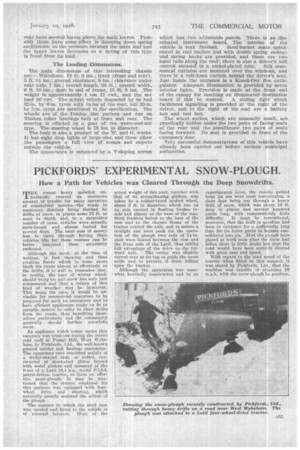PICKFORDS' EXPERIMENTAL SNOW-PLOUGH.
Page 57

If you've noticed an error in this article please click here to report it so we can fix it.
How a Path for Vehicles was Cleared Through the Deep Snowdrifts.
MBE recent heavy sinilvfali un doubtedly created an enormous amount of trouble for many operators of commercial motors—the roads in numerous districts being blocked by drifts of snow, in places some 18 ft. or more in depth, and, in a surprising number of cases, vehicles were actually snow-bound and almost buried for several days. The total sum of money lost to users through having their vehicles idle for these reasons can be better imagined than accurately reckoned.
Although the snow, at the time of writing, is fast thawing and thus creating floods which in some areas block the roads almost as effectively as the drifts, it is well to remember that, in reality, the part of winter which should bring ice and snow has only just commenced and that a return of this kind of weather may be imminent. This being the case, it would be advisable for commercial operators to be prepared for such an emergency and to have efficient appliances ready to fit to suitable motors in order to clear drifts from the roads, thus benefiting themselves particularly and the community generally should" further snowfalls occur.
An appliance -which comes under this category was tried out during the recent cold spell at Pound Hill, West Wykeham, by Pickfords, Ltd., the well-known general carrier and haulage contractor. The apparatus used consisted mainly of a wedge-shared ram, or cutter, constructed of sheet-steel plates braced with metal girders and mounted at the front of a Latil 38.1 h.p., niodel PAR4, petrol-driven tractor, to form an effective snow-plough. It may be mentioned that the tractor employed for this purpose was equipped with fourwheel drive and steering, which naturally greatly assisted the action of the plough.
The manner in which the steel ram was carried and fitted to the vehicle is of unusual interest. Most of the actual weight of this part, together with that of its strengthening girders, was taken by a rubber-tyred spoked wheel, about 2 ft. in diameter, which ran on an axle carried in floating bushes inside and almost at the nose of the ram. Steel framing bolted to the base of the ram and to the chassis frame of the tractor carried the axle, and to secure a straight and level push for the operation of the plough two rods of 11-in. steel were braced between the ram and the front axle of the Latil, thus taking full advantage of the drive on the for ward axle. The cutter was slightly curved over at its top to guide the snow aside and to prevent it from falling upon the tractor.
Altbongh the apparatus was somewhat hurriedly constructed and in an experimental form, the results gained from its use were most encouraging, a clear lane being cut through a heavy drift of snow, which was about 16 ft. deep in places and several hundred yards long, with comparatively little difficulty. It must be remembered, moreover, that the drift in question had been in existence for a sufficiently long time for its lower parts to become consolidated into ice. Had the plough been placed at work soon after the snow bad fallen there is little doubt but that the road would have been entirely cleared with great ease and speed.
With regard to the road speed of the tractor when fitted in this manner, it was stated by Pickfords, Ltd., that the machine was capable of attaining 16 m.p.h. with the snow-plough In positiom












































































































